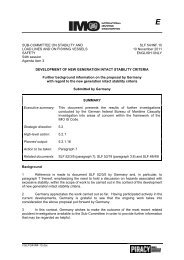Examination of the intact stability and the seakeeping behaviour
Examination of the intact stability and the seakeeping behaviour
Examination of the intact stability and the seakeeping behaviour
Create successful ePaper yourself
Turn your PDF publications into a flip-book with our unique Google optimized e-Paper software.
4.14 Vessel No. 14<br />
4.14 Vessel No. 14<br />
Figure 4.27: Lines plan <strong>and</strong> lateral areas <strong>of</strong> Vessel No. 14<br />
Table 4.27: Main dimensions <strong>of</strong> Vessel No. 14<br />
Main dimensions Value Unit<br />
L pp 319.00 [m]<br />
B 42.80 [m]<br />
T D 13.00 [m]<br />
Containers 8,600 [TEU]<br />
Vessel No. 14 has <strong>the</strong> geometric capacity to carry 8, 600 T EU. Having <strong>the</strong> main dimensions<br />
according to table 4.27, it belongs to <strong>the</strong> class <strong>of</strong> <strong>the</strong> large Post-Panamax vessels. With Vessel<br />
No. 14 <strong>the</strong> Chicago Express takes part <strong>of</strong> <strong>the</strong> analysis, which is <strong>the</strong> vessel involved in accident<br />
situation 1. For <strong>the</strong> BSU accident report [1] it has already been examined, although referring to<br />
a dierent loading condition. The following characteristics <strong>of</strong> <strong>the</strong> Chicago Express are to be<br />
noted:<br />
ˆ The lines <strong>of</strong> <strong>the</strong> ship shown in gure 4.27 have a c B value <strong>of</strong> 0.66 on design draft.<br />
ˆ The documented bilge keel area is a little bit larger than <strong>the</strong> mean value according to<br />
chapter 3.9.<br />
ˆ The <strong>stability</strong> in ballast arrival loading condition is extremely high resulting in a<br />
GM solid = 12.40 m.<br />
ˆ The limiting <strong>intact</strong> <strong>stability</strong> criterion (Max. GZ at 25 ◦ ) requires a GM min = 4.92 m.<br />
Besides Vessel No. 11, <strong>the</strong> Chicago Express is <strong>the</strong> second vessel in <strong>the</strong> examination out<br />
<strong>of</strong> <strong>the</strong> class <strong>of</strong> large Post-Panamax vessels. With a c B value <strong>of</strong> 0.66, <strong>the</strong> Chicago Express<br />
has not such a ne shaped hull as Vessel No. 11. But <strong>the</strong> <strong>stability</strong> values GM solid <strong>and</strong> most<br />
notably GM min also have a signicant higher order <strong>of</strong> magnitude, than <strong>the</strong> values for <strong>the</strong> smaller<br />
analysed vessels. The calculated transversal accelerations on <strong>the</strong> bridge <strong>and</strong> <strong>the</strong> rolling angles<br />
for <strong>the</strong> three accident conditions are listed in table 4.28.<br />
Table 4.28: Results <strong>of</strong> <strong>the</strong> <strong>seakeeping</strong> calculation for Vessel No. 14<br />
Accident<br />
[<br />
a<br />
situation t max m/s<br />
2 ] ϕ max [ ◦ ]<br />
Situation 1 3.0 7<br />
Situation 2 3.5 8<br />
Situation 3 3.0 8<br />
39

















